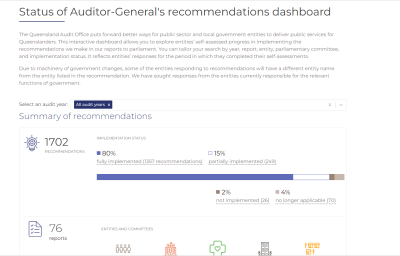Overview
The Queensland Audit Office (QAO) makes recommendations and provides insights to state and local government entities to help them improve the delivery of their services. This is important work that helps make a difference to the lives of Queenslanders.
This is our fourth report to parliament on the status of Auditor-General’s recommendations. We asked 84 entities to self-assess their progress in implementing 603 performance audit recommendations from 40 QAO reports tabled in parliament between 2015–16 and 2022–23. Based on these self-assessments, we share insights on the progress that has been made and highlight opportunities for improvement.
Tabled 20 September 2024.

Report on a page
The Queensland Audit Office makes recommendations to state and local government entities to support better delivery of public services and improve the lives of Queenslanders.
In this report, we share insights from our analysis of entities’ reported progress against the recommendations we made. We highlight common challenges and opportunities for the public sector and how entities can improve their systems and practices.
Our recommendations focus on many different aspects of public service delivery. We ensure our recommendations are client focused, address the root cause, and add value to the public sector.
What did we examine?
Note: These 40 reports to parliament included 181 unique recommendations. However, we made some of these recommendations to multiple entities, which we count as individual recommendations. So overall, we made 603 individual recommendations.
What did we find?
Entities reported the following progress with implementing our recommendations.
Appendix B summarises entities’ self-assessed progress in implementing our recommendations. The best way to explore their reported progress on each recommendation is via our interactive dashboard available at www.qao.qld.gov.au.
Insights from entities’ responses
|

1. Insights – recommendations and responses
We design our recommendations to help our clients improve their service delivery and learn from the better practices of others. We consult with entities when drafting our recommendations and we ask them to confirm whether they agree with our recommendations. Although we cannot make entities implement our recommendations, we track, report, and share insights on their progress.
For this report, we asked 84 public sector entities, including local governments, to self-assess their progress in implementing the performance audit recommendations we issued from:
- 9 new reports (8 reports tabled in 2022–23 and our Conserving threatened species report tabled in 2018–19)
- 31 reports from earlier years that had outstanding recommendations (we define ‘outstanding recommendations’ as those either not implemented or partially implemented from last year’s report).
We did not follow up the recommendations from Conserving threatened species (Report 7: 2018–19) previously, because at the time we were undertaking a follow-up audit to assess entity progress. We have subsequently completed the follow-up audit Protecting our threatened animals and plants (Report 9: 2022–23) and included the outstanding recommendations from the original report in this year’s self-assessment process.
Entities reported their progress to us at the end of May 2024. This report reflects the status of entities’ self-assessed progress in implementing our recommendations at that time. We have not audited the actions they have taken, and therefore cannot provide assurance over their responses.
We asked entities to assess whether they had fully, partially, or not implemented our recommendations, or whether they assessed the recommendations as no longer applicable (using the criteria detailed in Appendix D). Where entities report fully implementing our recommendations, we expect their actions to address the issue we identified and be operating effectively, not to be a plan to address the issue.
Insights into our most frequent recommendations
We analysed all the recommendations we made in new reports (those reports that we have requested a status update on for the first time) to identify those we made most often. This gives us some indication of what entities find most challenging. We grouped our recommendations into 10 categories, as shown in Figure 1A.

Note: We acknowledge that some of the categories above, like risk management, form part of governance. We have separated these to allow for richer analysis.
Queensland Audit Office.
Our interactive dashboard captures all recommendation categories from prior years, and is available at www.qao.qld.gov.au/status-auditor-generals-recommendations-dashboard.
Appendix C explains these categories and shows entities’ reported progress against them.
Figure 1B shows the 3 most common categories of recommendations we made in new reports and the underlying issues our recommendations sought to address.
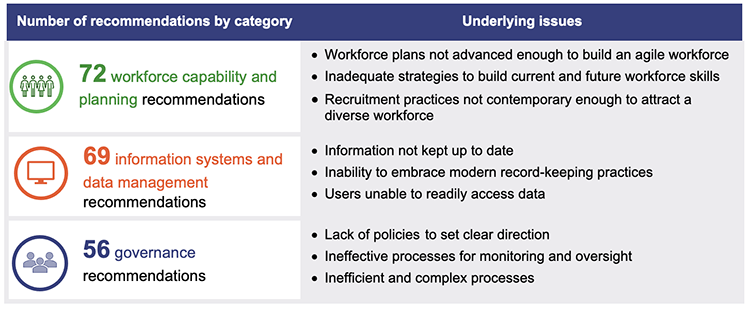
Queensland Audit Office using data self-reported by entities.
Insights into outstanding recommendations
We analysed entities’ progress against the 10 categories to identify which had the highest number of outstanding recommendations from new reports.
The most common types of outstanding recommendations related to workforce capability and planning and governance, followed by risk management. While information systems and data management were the second-most common recommendations we made, entities reported making good progress in implementing them. They reported fully implementing 65 per cent (45) of the 69 information systems and data management recommendations.
Figure 1C shows the status of the 3 most common categories of outstanding recommendations in new reports.

Note: There are 155 outstanding recommendations in total, consisting of 152 outstanding recommendations in 2022–23 and 3 outstanding recommendations from our report Conserving threatened species (Report 7: 2018–19).
Queensland Audit Office using data self-reported by entities.
Workforce capability and planning
Workforce planning is critical in ensuring entities can deliver on their priorities (both now and in the future) and respond to unforeseen challenges. It can include assessing their workforce capability, enhancing their training and development programs, allocating resources to areas of priority, and implementing strategies for recruitment and retention. In 2022–23, we made 72 recommendations from 3 reports about where entities could improve their workforce planning by:
- developing more agile strategies that can build adaptable workforces and meet changing needs
- incorporating strategies to build current and future workforce skills
- implementing more contemporary recruitment practices to attract the right staff and a diverse workforce.
Entities reported implementing 60 per cent (43) of the 72 recommendations, with 40 per cent (29) still outstanding. Most of the outstanding recommendations were from our report on Managing workforce agility in the Queensland public sector (Report 6: 2022–23). Entities reported that they have developed strategic workforce plans, but need to do more work to embed them.
Workforce planning remains a focus area for our office. We plan to examine the adequacy of the teacher workforce to meet Queensland’s student population in our upcoming audit on Managing the supply of teachers. We will also examine the effectiveness of the Queensland workforce strategy to reduce labour and skills shortages in our planned audit Reducing labour and skill shortages. These audits are included on our Forward work plan 2024–27, available on our website at www.qao.qld.gov.au/audit-program.
Governance
Entities need good governance to be transparent and accountable and to drive improvement.
In 2022–23, we made 56 recommendations from 6 reports to strengthen entities’ governance arrangements by:
- developing policies that provide clear guidelines and ensure consistency
- establishing clear leadership, responsibility, and accountability
- enhancing systems and approaches to improve monitoring.
Entities reported implementing 48 per cent (27) of the 56 recommendations, with 48 per cent (27) still outstanding. They assessed the remaining 4 per cent (2) of recommendations as no longer applicable. Most of the outstanding governance recommendations were from our report Health outcomes for First Nations people (Report 14: 2022–23). This was not unexpected as we only tabled it in June 2023, meaning these entities had less than 12 months to implement these recommendations before we requested this status update. Many entities responded that they would be able to implement the recommendations in 2024–25. While entities have made progress in implementing approximately half of these recommendations, they need to continue to implement the remaining ones.
Risk management
Entities need a strong risk management approach to proactively identify, manage, and mitigate the risks they may face. Queensland public sector entities and local governments face many existing and emerging risks and challenges in delivering public services. These include the emergence of new technologies, extreme weather events, cyber risks, and privacy breaches. These risks and others can result in financial loss and disruption to service delivery. In 2022–23, we made 44 recommendations from 3 reports where entities could strengthen their risk management practices by:
- allocating responsibility to identify, monitor, and manage risks
- regularly updating their risk assessment tools.
Entities reported implementing 45 per cent (20) of the 44 recommendations, with 50 per cent (22) of the recommendations still outstanding. They assessed the remaining 5 per cent (2) as no longer applicable.
Most of the outstanding risk management recommendations were from our report Improving grants management (Report 2: 2022–23). Risk management remains a key focus for our office. We plan to examine the effectiveness of risk management practices in our upcoming audits Transferring risk in infrastructure projects and Managing third party cyber security risks, described in our Forward work plan 2024–27 available on our website at www.qao.qld.gov.au/audit-program.
Insights from entities’ responses
Implementing machinery of government changes
The government of the day has the right to decide how best to organise the functions it governs. Restructures of government functions (known as machinery of government changes) involve the movement of functions, resources, and people from one department to another.
In our report Implementing machinery of government changes (Report 17: 2022–23), we assessed the impact of restructures on departments’ systems, processes, and people. We only tabled this report in late June 2023 and entities had less than 12 months to implement the recommendations when we requested their status updates in May 2024.
Our report identified 3 key challenges entities face when implementing machinery of government changes. Figure 1D shows these.
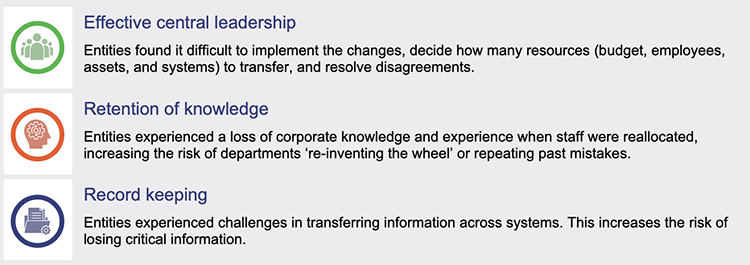
Queensland Audit Office.
Machinery of government changes require considerable time and effort, and can create risks that need to be managed.
Preparing for future machinery of government changes
To address the challenges created by government restructures, we made 7 recommendations. We directed 4 of these to the Public Sector Commission (the commission). The commission has a legislative role to oversee the implementation of changes to the machinery of government and resourcing decisions related to these changes. We recommended the commission review its framework to help entities prepare and implement future machinery of government changes. The commission has reported partially implementing this recommendation, noting that it will undertake further work to engage and support entities to fully implement it.
We directed 5 of the 7 recommendations to multiple departments. Overall, entities have made progress in implementing our recommendations. They reported implementing 57 per cent (41) of the 72 recommendations. While entities have had a relatively short period, 11 months, to progress these recommendations, some entities identified that they would be fully implemented by October 2024.

2. Status of implementation
We make recommendations to help entities improve the public services they deliver. Our recommendations may address strategic issues, performance gaps, inefficiencies, and unnecessary risk across the public sector. We may also identify better practices, which other entities can learn from. In this section, we discuss the progress that entities reported in implementing our recommendations. This includes:
- 380 recommendations from 9 new reports (8 reports tabled in 2022–23 and our Conserving threatened species report tabled in 2018–19)
- 223 recommendations from 31 reports tabled between 2015–16 and 2021–22, which entities reported as outstanding (partially implemented and not implemented) in last year’s report.
We begin with the overall status of implementation and then show the status of recommendations from reports tabled in 2022–23 and our report Conserving threatened species (Report 7: 2018–19). We also provide detailed analysis for specific reports selected based on their number of outstanding recommendations or important themes. We then report on the implementation of recommendations by departments, hospital and health services, local governments, and other entities.
Overall status of implementation
We asked 84 entities to self-assess their progress in implementing 603 performance audit recommendations from 40 reports between 2015–16 and 2022–23. Appendix B includes a list of the reports we asked entities to self-assess against, and a summary of entities’ self-assessed progress.
Entities reported that they had:
- fully implemented 52 per cent (312)
- partially implemented 41 per cent (249)
- not implemented 4 per cent (26).
They also reported that 3 per cent (16) of recommendations were no longer applicable to them. Figure 2A shows the status of all recommendations from new reports and the status of recommendations that entities reported were outstanding last year.
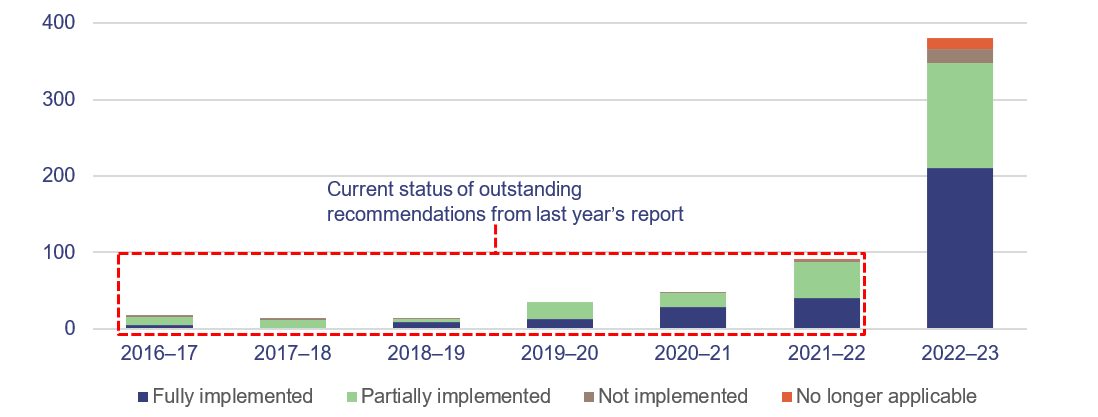
Note: This year entities reported fully implementing the 3 outstanding recommendations from our report Queensland public hospital operating theatre efficiency (Report 15: 2015–16), as such we excluded these from the figure above.
Queensland Audit Office using data self-reported by entities.
Status of recommendations from 2022–23
2022–23 reports to parliament with fully implemented recommendations
One of the 8 reports to parliament from 2022–23 had no outstanding recommendations. The recommendations from Delivering social housing services (Report 1: 2022–23) were allocated to the Department of Housing, Local Government, Planning and Public Works. It reported fully implementing all recommendations from this report. It has developed a new framework as recommended but it will not be operational until March 2025.
2022–23 reports to parliament with outstanding recommendations
Entities reported that the remaining 7 reports to parliament from 2022–23 have outstanding recommendations. We ask entities whether they accept the recommendations and when they expect to implement them. Some recommendations take longer to implement than others and we only want entities to report that they have fully implemented them when the actions they have taken are operating effectively. We show the status of outstanding recommendations in Figure 2B.
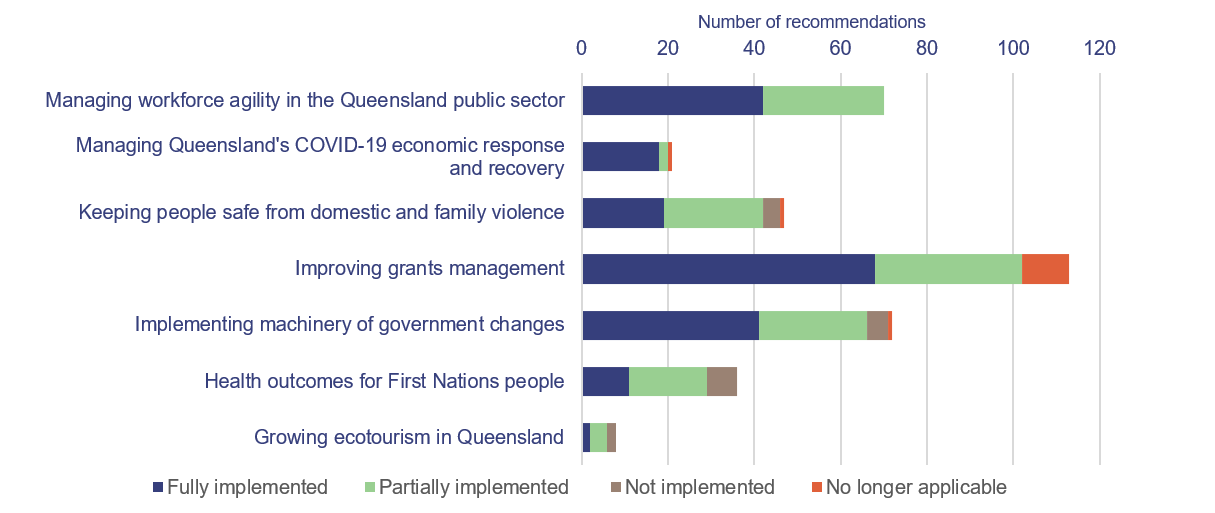
Queensland Audit Office using data self-reported by entities.
In the following section, we break down the progress that entities reported in implementing recommendations from our report Improving grants management (Report 2: 2022–23), tabled in July 2022. We selected this report based on the number of outstanding recommendations and the inherent risks associated with managing grants. Entities we addressed recommendations to in this report have had almost 2 years to progress them.
Managing grants effectively
The systems and processes for grants management are a fundamental part of the way government operates. In 2022–23, Queensland Government entities paid $3.1 billion in grants to various community groups, local governments, businesses, and others to support the objectives and priorities of the government.
Each year, Queensland Government departments and the Queensland Reconstruction Authority publish information on the funding of frontline services and grant programs on the Queensland Government Open Data Portal. The information supports transparency and accountability so people can understand what the government funded in their local communities.
In Improving grants management, we provided insights into where Queensland Government grants go. We assessed the strengths and weaknesses of the internal controls (people, systems, and processes) used by 5 departments in managing 8 grant programs. We found entities could strengthen how they collect and publish all the relevant information in an efficient way.
We made 8 recommendations, including:
- 2 recommendations to Queensland Treasury
- one recommendation to the Department of State Development, Infrastructure, Local Government and Planning
- 5 recommendations to all departments and the Queensland Reconstruction Authority (110 recommendations in total).
We directed 2 recommendations to Queensland Treasury because it has a central role in providing advice to departments about managing grants and determining what information they collect and make public about the allocation of grants.
We recommended that Queensland Treasury re-assess the cost and benefits of developing an interactive dashboard for the public. We made this recommendation to provide greater transparency about the distribution of grant funding. An interactive dashboard would allow Queensland Treasury to better understand the information needs of users and determine future data collections for publication. Queensland Treasury agreed to this recommendation in principle when the report was tabled. It now advises that this recommendation is no longer applicable, because the Queensland Audit Office already publishes a comprehensive dashboard about grants information using the Queensland Government Open Data Portal. While this is correct, the Auditor-General Act 2009 limits our ability to publish information we obtain from our audits. This means our ability to update the dashboard more frequently (currently annually) with data more tailored to what the community wants to know is limited, as we are restricted to reporting the data that Queensland Treasury already reports publicly.
By developing and maintaining its own dashboard, Queensland Treasury could provide greater transparency on the distribution of grant funding. It could gain insights into the information the public is accessing and better understand its needs. It may also help inform what additional data departments need to collect, and what data is no longer required.
We also recommended that the Department of State Development, Infrastructure, Local Government and Planning lead improvements in grants management across government. The lead department, now the Department of State Development and Infrastructure, reported that it has fully implemented this recommendation. It is leading a whole-of-government grants maturity program, which includes a centre of expertise that provides guidance, tools, and templates. The program focuses on developing skills and building capability and will support access to a common grants information system.
Departments and the Queensland Reconstruction Authority reported implementing most of the recommendations we addressed to them in our report Improving grants management (Report 2: 2022–23). Of the 110 recommendations made to the Queensland Reconstruction Authority and all departments, they reported 31 per cent (34) were still outstanding. Some entities have not self-assessed their grants management processes with our grants management maturity model, and therefore cannot identify the strengths and weaknesses in their current programs.
Queensland Corrective Services reported that the 5 recommendations for its grant programs were no longer applicable. This is because its grant expenditure is immaterial. We agree that these recommendations are no longer applicable.
The Department of the Premier and Cabinet also reported that 5 recommendations from this report were no longer applicable. It reported that the business function responsible for its grants program moved to the Department of Treaty, Aboriginal and Torres Strait Islander Partnerships, Communities and the Arts. We also agree that these recommendations are no longer applicable.
Recommendations assessed as no longer applicable
In addition to the 11 recommendations assessed as no longer applicable from the Improving grants management report included above, 3 departments reported that 3 recommendations from 3 reports in 2022–23 were no longer applicable:
- Managing Queensland’s COVID-19 economic response and recovery (Report 3: 2022–23)
– one recommendation - Keeping people safe from domestic and family violence (Report 5: 2022–23)
– one recommendation - Implementing machinery of government changes (Report 17: 2022–23) – one recommendation.
Managing Queensland’s COVID-19 economic response and recovery
Queensland Treasury reported that recommendation 6 from Managing Queensland’s COVID-19 economic response and recovery, for it to enhance its oversight of rapid response initiatives, was no longer applicable. Queensland Treasury will continue to provide oversight of the COVID-19 economic response and recovery initiative through its fiscal monitoring processes. We agree that this recommendation is no longer applicable. While the current environment does not require rapid response initiatives, it is important that Queensland Treasury is prepared for future events (whether they be economic, public health, or climate related) that may require a rapid response.
Keeping people safe from domestic and family violence
The Department of Child Safety, Seniors and Disability Services reported that one recommendation from the report Keeping people safe from domestic and family violence was no longer applicable. It reported that responsibility for rehabilitating young people moved to the Department of Youth Justice. We agree that this recommendation is no longer applicable to the Department of Child Safety, Seniors and Disability Services.
Implementing machinery of government changes
The Department of Health reported recommendation 7 (implementing a whole-of-government record‑keeping system) was no longer applicable. It reported that the recommendation would be challenging to implement, as it would require significant investment in information and communication technology systems and would need a lead agency to take responsibility for implementation. It is unlikely that the Department of Health will be impacted by machinery of government changes that will require it to transfer records to another department. We agree that this recommendation is no longer applicable.
Status of recommendations from Conserving threatened species
In addition to reports tabled in 2022–23, we followed up on the status of recommendations from our report Conserving threatened species (Report 7: 2018–19). In this report, we made 7 recommendations. We did not follow up the recommendations from this report last year, because at the time we were undertaking a follow-up audit to assess the department’s progress. We have subsequently completed the follow-up audit Protecting our threatened animals and plants (Report 9: 2022–23), which identified that the department had fully implemented 2 of the 7 recommendations. As part of this year’s self-assessment process, we followed up entity progress for the remaining 5 recommendations from the original report. We did not make any new recommendations in our follow-up report.
The Department of Environment, Science and Innovation reported that it had fully implemented 40 per cent (2) and partially implemented 60 per cent (3) of the recommendations.
Status of outstanding recommendations from prior years
In our report 2023 status of Auditor-General’s recommendations (Report 3: 2023–24), we highlighted that 223 recommendations were outstanding. Of these, entities reported this year:
- fully implementing 45 per cent (101)
- partially implementing 50 per cent (112)
- not implementing 4 per cent (8).
They reported that the remaining one per cent (2) of recommendations were no longer applicable.
Age of outstanding recommendations
We assessed the age of recommendations outstanding from reports tabled from 2016–17 to 2021–22. We excluded from our analysis outstanding recommendations from new reports, given some entities had less than one year to implement them. Figure 2C shows the age of the 120 outstanding recommendations.
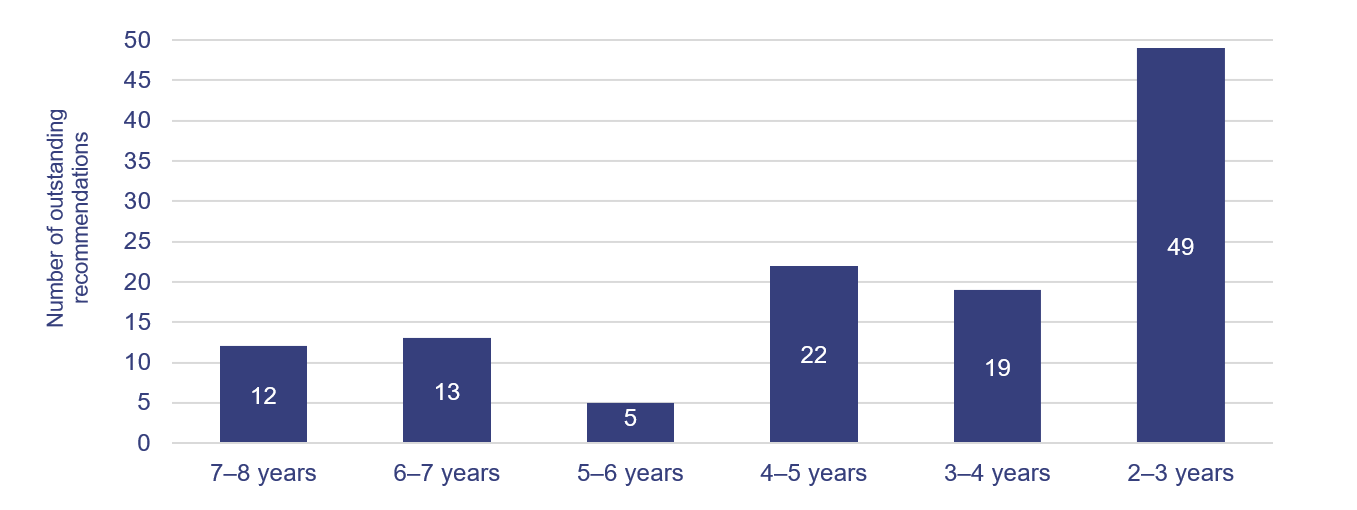
Queensland Audit Office using data self-reported by entities.
There are 12 recommendations (11 partially implemented and one not implemented) from our report Forecasting long-term sustainability of local government (Report 2: 2016–17) that remain outstanding, despite being issued more than 7 years ago. Similarly, 13 recommendations from 3 reports tabled in 2017–18 remain outstanding despite being issued more than 6 years ago. These include:
- 2 recommendations partially implemented from our reports The National Disability Insurance Scheme (Report 14: 2017–18) and Follow-up of Managing water quality in Great Barrier Reef catchments (Report 16: 2017–18)
- 11 recommendations (9 partially implemented and 2 not implemented) from our report Managing local government rates and charges (Report 17: 2017–18).
Recommendations assessed as no longer applicable
Entities reported that 2 recommendations from 2 reports in 2021–22 were no longer applicable.
South West Hospital and Health Service (South West HHS) reported that recommendation 5 from Measuring emergency department patient wait time (Report 2: 2021–22) was no longer applicable. The recommendation required hospital and health services to monitor and report on short-term treatment areas. South West HHS reported that its emergency departments do not contain short-term treatment areas. We agree that this recommendation is no longer applicable.
The Department of Energy and Climate reported that recommendation 11 from the report Contract management for new infrastructure (Report 16: 2021–22) was no longer applicable. It reported that the business area responsible for managing contracts had moved following the December 2023 machinery of government changes to the Department of Housing, Local Government, Planning and Public Works (DHLGPPW). DHLGPPW has addressed this recommendation by implementing new contract management practices. We agree that this recommendation is no longer applicable.
Progress of implementation by entity type
In the following section, we analyse reported progress in implementing recommendations by departments, hospital and health services, local governments, and other entities.
Departments
We asked 23 departments to self-assess their progress in implementing 321 recommendations issued to them in 2022–23 and 90 outstanding recommendations from last year’s report. They reported implementing 58 per cent of the total 411 recommendations made to them.
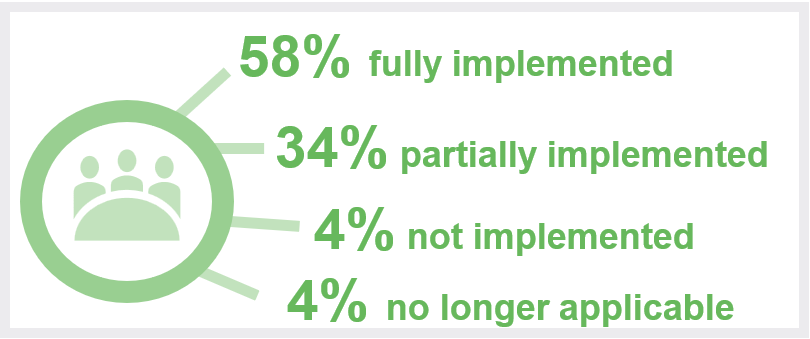
Note: Figures show the status of recommendations made in 2022–23 and outstanding recommendations from prior years.
Queensland Audit Office.
The Department of Transport and Main Roads is the only department that reported fully implementing all recommendations. Figure 2E shows the departments with outstanding recommendations.
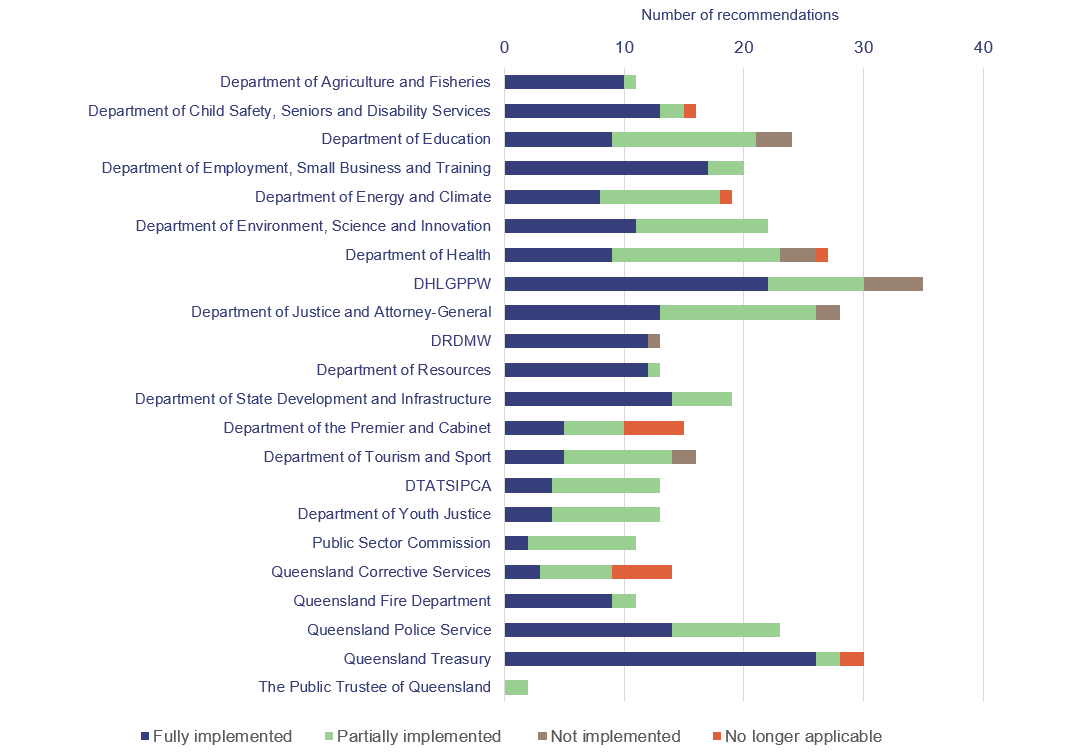
Note: DHLGPPW – Department of Housing, Local Government, Planning and Public Works; DRDMW – Department of Regional Development, Manufacturing and Water; DTATSIPCA – Department of Treaty, Aboriginal and Torres Strait Islander Partnerships, Communities and the Arts.
Queensland Audit Office using data self-reported by entities.
Some departments provided detailed responses explaining the action they took, including the outcomes of those actions; others provided responses that lacked detail. For example, the Department of State Development and Infrastructure reported fully implementing 3 recommendations from our report Managing Queensland’s COVID-19 economic response and recovery (Report 3: 2022–23). However, it did not explain the action it had taken or the outcome of its action. Similarly, Queensland Treasury reported that it had fully implemented recommendations 1 to 5 from this report. It provided no explanation of the action it had taken, only what it plans to do in the future. It is important that entities provide sufficient detail to explain the action they have taken.
In last year’s report, the Department of State Development and Infrastructure reported that it had partially implemented recommendation 1 from our report Managing local government rates and charges (Report 17: 2017–18). Responsibility for this recommendation transferred to the Department of Housing, Local Government, Planning and Public Works as a result of the machinery of government changes in December 2023. In contrast, it reported that this recommendation was not implemented.
The level of detail entities include in their self-assessment does not always make it clear if the status they assigned to the recommendation is appropriate or how machinery of government changes impact the progress of recommendations they become responsible for. We do not provide any assurance on the self‑reported status of the recommendations.
Hospital and health services (HHSs)
We asked 16 HHSs to self-assess their progress implementing 48 recommendations made in 2022–23 and 49 outstanding recommendations from last year’s report. They reported fully implementing 48 per cent of the 97 recommendations.
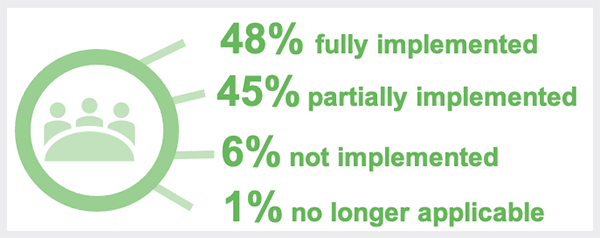
Note: Figures show the status of recommendations made in 2022–23 and outstanding recommendations from prior years.
Children’s Health Queensland Hospital and Health Service reported fully implementing all recommendations. Figure 2G shows the 15 HHSs that reported outstanding recommendations.
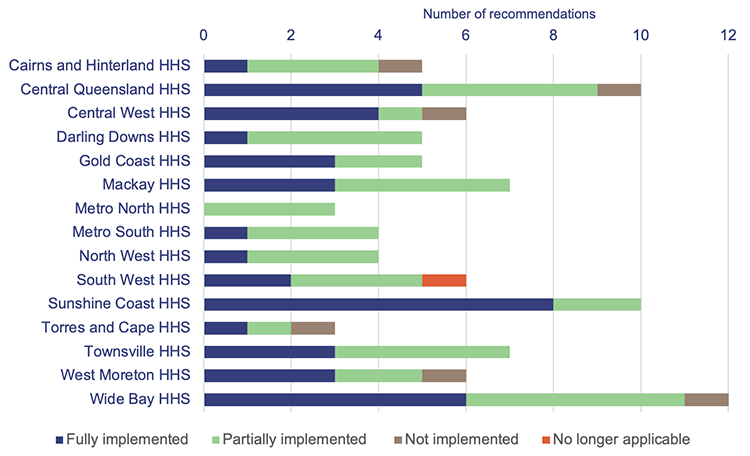
Queensland Audit Office using data self-reported by entities.
We tabled 2 reports in 2022–23 with recommendations addressed to all HHSs.
In our report Keeping people safe from domestic and family violence (Report 5: 2022–23), we made recommendation 15 to all HHSs (16 recommendations in total). The recommendation covered strengthening critical screening and risk assessing practices for vulnerable children and adolescents. We recommended mandating delivery of face‑to‑face domestic and family violence training for all frontline health workers. HHSs reported their progress implementing this recommendation:
- fully implemented 19 per cent (3)
- partially implemented 69 per cent (11)
- not implemented 12 per cent (2).
Central West HHS reported that it had not progressed recommendation 15, but did not explain why. Torres and Cape HHS reported that it had not implemented recommendation 15 because it is waiting on the Department of Health to develop tools and an implementation plan, which it plans to adopt.
We made 2 recommendations to all 16 HHSs (32 recommendations in total) in Health outcomes for First Nations people (Report 14: 2022–23). As this report was tabled in June 2023, entities have only had just under 12 months to implement the recommendations. HHSs reported:
- fully implementing 34 per cent (11)
- partially implementing 53 per cent (17)
- not implementing 13 per cent (4).
Four HHSs reported that they have not implemented these recommendations but have a plan to address them in the future. The HHSs reported they are working with the Department of Health to update their First Nations health equity strategy implementation plans with detailed actions and costings.
Local governments
We made no new recommendations to local governments (councils) in our reports tabled in 2022–23. We asked 29 councils to self‑assess their progress implementing the 57 outstanding recommendations from last year’s report. The following 5 councils reported implementing all recommendations:
- Gold Coast City Council
- lsaac Regional Council
- Lockyer Valley Regional Council
- Mackay Regional Council
- Moreton Bay City Council.
Twenty-four councils reported having outstanding recommendations.
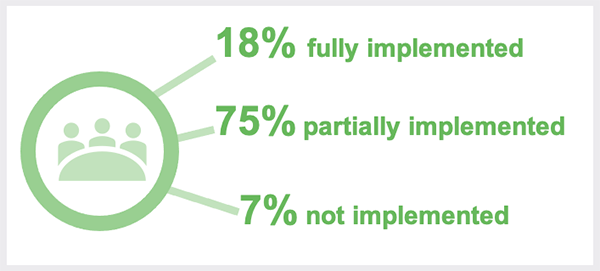
Note: Figures show the status of recommendations made in 2022–23 and outstanding recommendations from prior years.
Queensland Audit Office.
Figure 2I shows the status of recommendations by councils that reported having outstanding recommendations. Councils vary widely in their size and location, and in the range of community services they provide. To enable comparison, we have grouped them into 5 common segments used by the Local Government Association of Queensland: Coastal, Resources, Rural/Regional, Rural/Remote, and South East Queensland.
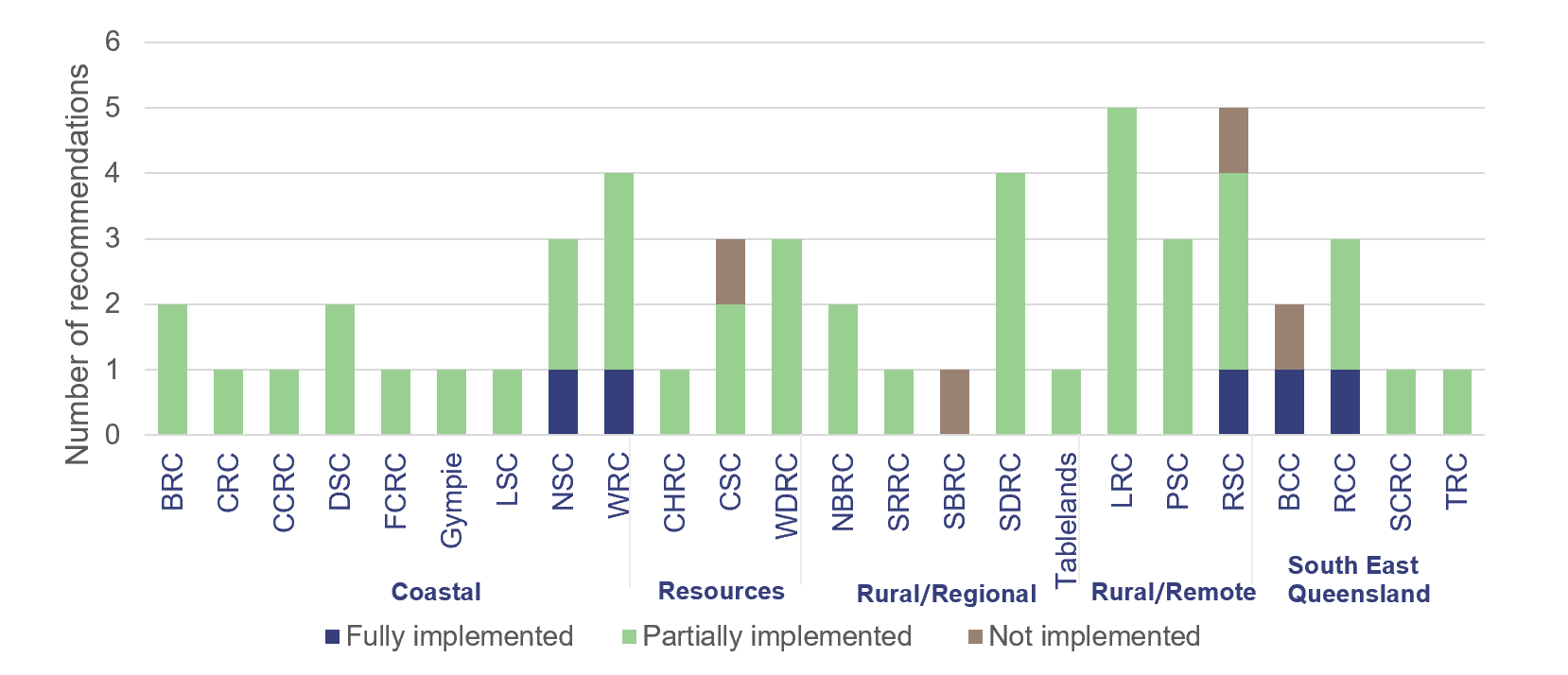
Note: BRC – Bundaberg Regional Council; CRC – Cairns Regional Council; CCRC – Cassowary Coast Regional Council; DSC – Douglas Shire Council; FCRC – Fraser Coast Regional Council; Gympie – Gympie Regional Council; LSC – Livingstone Shire Council; NSC – Noosa Shire Council; WRC – Whitsunday Regional Council; CHRC – Central Highlands Regional Council; CSC – Cook Shire Council; WDRC – Western Downs Regional Council; NBRC – North Burnett Regional Council; SRRC – Scenic Rim Regional Council; SBRC – South Burnett Regional Council; SDRC – Southern Downs Regional Council; Tablelands – Tablelands Regional Council; LRC – Longreach Regional Council; PSC – Paroo Shire Council; RSC – Richmond Shire Council; BCC – Brisbane City Council; RCC – Redland City Council; SCRC – Sunshine Coast Regional Council; TRC – Toowoomba Regional Council.
Queensland Audit Office using data self-reported by entities.
Councils reported limited progress in implementing the 57 outstanding recommendations. They reported fully implementing 18 per cent (10) recommendations with 82 per cent (47) outstanding. Councils are failing to address our recommendations, particularly from our series of local government sustainability audits. Of the 47 outstanding recommendations, 70 per cent (33) were from these reports tabled between 2016–17 and 2018–19. We made some of these recommendations to councils more than 7 years ago.
We conducted another audit in our series on the sustainability of local governments in 2023–24, Improving asset management in local government (Report 2: 2023–24). In this audit, we continued to see recurring issues with councils’ long-term planning and forecasting, which are important for their financial sustainability. Councils need to implement these recommendations quickly and effectively to ensure they are financially sustainable to deliver critical services to their communities.
Councils play a vital role in our communities and our office will continue to focus on their sustainability, to help them improve their planning, processes, and service delivery. In 2025–26, we plan to undertake an audit on Enhancing the sustainability of local governments. This audit will be the fifth in our series of local government sustainability audits. We will examine councils’ progress in implementing our recommendations from our series, and how they are meeting their sustainability challenges. We will also provide insights into the effectiveness of audit committees in local government through our report Effectiveness of local government audit committees, which we plan to table in 2024–25.
We found that some councils have not reported any progress on the outstanding recommendations. For example, South Burnett Regional Council reported last year that it had not implemented recommendation 5 from our report Regulating animal welfare services (Report 6: 2021–22) to assess all its regulatory responsibilities (not just those related to regulating animal welfare). This year it reported that it had still not implemented this recommendation because of resourcing challenges. Similarly to last year, Western Downs Regional Council reported that it had only partially implemented 3 recommendations from our report Managing the sustainability of local government services (Report 2: 2019–20).
Other entities
We asked other state entities to self-assess their progress implementing 11 recommendations made to them in 2022–23 and 27 outstanding recommendations from last year’s report.
The entities reported fully implementing 47 per cent (18) and partially implementing 53 per cent (20) of the 38 recommendations.

